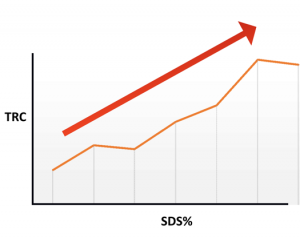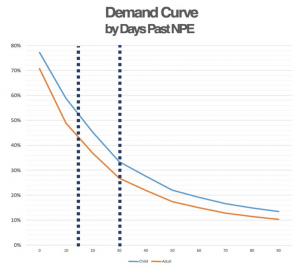In previous posts, I shared some of the data we are collecting at OrthoFi. In a series of blog posts, I hope to share more of the data we have collected from over 60,000 starts and over $300,000,000 in orthodontic production. Today we discuss pending management.
One thing we all struggle with is being ‘salesy’. No one wants to be perceived as a slimy salesperson. And, as health-care providers, any perception of sales in our business has historically been frowned upon. As Daniel Pink states in his book To Sell is Human, we are all in sales. Hopefully, you only recommend treatment when it is in the best interest of the patient to have treatment. So, after your recommendation, it is not a good thing if the patient chooses not to pursue treatment, and I presume that you all feel like your treatment is better than what someone might get elsewhere. If you don’t, time to call Derek Bock.
With that good faith sentiment, it’s in everyone’s best interest for the patient to start with you. Whether we like it or not, taking a person from being recommended treatment to starting treatment happens as part of a sales process. Therefore, it is in our best interest, and the best interest of the patient, for orthodontists to become familiar with sales techniques and statistics. As shared in a previous post, same day starts are important. Like really important. We now have the data to show a direct and linear correlation exists between same day starts and treatment recommended conversion (TRC–#starts/#recommends) as depicted in the following graph.
You can see that the more same day starts you do in your office the higher your Treatment Recommended Conversion (TRC) will likely be. As hard as we try, however, not everyone will start the same day. Many people really do need to go home and talk to dad, think about it, get dental work done, etc. From a benchmarking perspective, the highest SDS% (meaning the percentage of all starts that are Same Day Starts) across 140 OrthoFi practices is 75%. This is not my practice by the way, but we are working on it. That’s a seriously impressive number. The average SDS% across all practices is over 30%. Although I’ve never seen an industry-wide statistic on SDS%, my suspicion is the average across all practices nationwide is much lower. Hence, the true conversion percentage across all orthodontists has been reported at around 50%.
Why do we feel so strongly that same day starts are so important? Because people today are highly distracted. Once a person leaves the office and becomes ‘pending’, you are competing with all manner of other distractions and expenses which diminish their likelihood of deciding to start treatment in your office. The reality is that many other things compete for patient dollars besides orthodontics. Especially with adults, it’s not just our dental competitors, but also school supplies, family vacations, botox, a new muffler, or a million other choices for family dollars other than orthodontics. We have irrefutable data about what happens when treatment is recommended and the patient leaves the office without starting treatment (classifying the patient as ‘pending’). Let’s take a look:
This graph shows the TRC on the Y-axis and number of days from the exam recommend on the X-axis. The orange line is adults and the blue line is kids. The reason why same day starts are so important is because as soon as they walk out the door, the chance of you converting them falls off a proverbial cliff. The likelihood of converting the patient drops 20% the moment they leave and decays by 35% for children and 45% for adults over the first two weeks. A lot of offices do their follow-ups in batches every other week or once a week. If you’re one of these, you are likely cutting your chances of converting the patient by almost half. Yes, that reads ‘half’.
One of the main leading indicator performance metrics OrthoFi reports is ‘45-day TRC’. This is the number of patients who convert within 45 days of you recommending treatment. Why do we focus on this? Because we now know that the chances of converting the patient drops between 75-80% by 45 days post-recommend. So even though you may occasionally have patients come back after that time, there’s no question that the early bird gets the worm as the expression goes.
Following a treatment recommend, it is important that the Treatment Coordinator ask some questions to begin the follow up process. Typically, if the parent wants to ‘think about it’ or ‘talk to dad’ then the response is ‘OK, why don’t you go home and talk to dad and give me a call when you have decided’. Then, the official follow-up system of the office stops while they wait for the person to re-contact the office to initiate treatment. As Ben Burris has stated previously, the person did not come to the office in the first place because they weren’t interested in treatment. A preferred method (assuming the TC has already asked to schedule the start and was declined) might be for the TC to take control of the conversation and say, “I’d like to set a time to follow up with you and answer any last questions you may have. I can be available to you on Tuesday or Wednesday. Which would you prefer?” This not only sets the expectation that you will be following up, but also makes the patient understand that your TC’s time is valuable and they will be taking time from their schedule to follow up and answer any questions they may have.
Then, you have to make sure you have solid and consistent systems around your follow-up management to ensure every patient gets the same experience. This cannot be accomplished with the traditional batch process making calls every other week. When you do that, some of your potentials are getting called right away (good), and others are waiting 2 weeks to get a touch (bad). How do big businesses manage follow up? With CRM (Customer Relationship Management) systems like SalesForce®, and automated drip marketing. These systems allow you to set the standard follow-up cadence you want to adopt, will then prompt you when it’s time for a touch for that customer, and will even send automated drip messages at designated times. Instead of having to remember to pull that pending report and make calls when you think about it or have time (losing opportunities each day in between), the system pings you when it’s time. Instead of letting things pile up to a batch of 30-50 calls every other Friday, your team would be making a handful each day. Same work, just scheduled differently. By using this follow-up methodology (often called ‘just in time’ or ‘lean’ management) you are always striking while the iron is hot. Drip email systems like InfusionSoft are also great to help supplement your live calls or emails to fill in the gaps, and also help you stay connected to some leads who may have drifted beyond the 45 days.
Here is a sample of a follow-up sequence we use in our office, including a couple of our email templates to help get you kickstarted. The cadence is based on the demand curve, to make sure we catch them before another big dip. The message starts as presumptive and short, to more marketing inspirational stuff to get them back into the buying mindset. There is, of course, a fine line between excellent follow-up and being pushy, so careful not to cross the line. We’ve found this sequence is still well inside of pushy. And remember, the sequence stops if the patient starts or doesn’t want any more follow up:
- If the patient doesn’t sign today and they don’t schedule the start while in the office, the TC offers to ‘make themselves available’ as described above. If a call isn’t scheduled, the follow-up sequence kicks off.
- 24-hours – follow-up call. If leaving a message, be sure to set expectations by saying ‘If I don’t hear back from you, I’ll follow-up in a couple days’. This will make your next touch point more expected and less pushy.
- 3 days (72 hrs) – text message (see template)
- 1 week – 1st email (see email scripting below) + Phone Call
- 2 weeks – text message
- 4 weeks – 2nd email
- 6 weeks – text message w/ promo tease
- 8 weeks – ‘LAST CHANCE’ email w/ limited-time whitening promo or something similar
1ST EMAIL
Thank you so much for taking time to visit with me and Dr. Reynolds/Dr. Dopp/Dr. Spillane to review the benefits of orthodontic care. We look forward to having you as part of our practice and to designing (patient’s name)’s Amazing Smile! CALL US TODAY to get started.
CLICK HERE to download a free report that can help you understand key factors consider when choosing an orthodontist: www.OrthoQuestions.com.
Thank you!
2nd EMAIL
I’m not sure if you received my email from last week, but I wanted to follow up with you to see if you’re ready to get started with [pt name]’s treatment or if you had any remaining questions . We look forward to welcoming you to the practice and providing the very best care. A beautiful healthy smile is not only important for [your/patient name’s] long-term dental health, but can be life-changing in terms of confidence and future career success.
CLICK HERE to see how Spillane & Reynolds patients feel about their new smile [VIDEO]
Thank you!
As mentioned above, sequenced follow-up campaigns are typically called ‘drip’ campaigns, as the information comes in small doses (drips) rather than one big tidal wave. Traditionally, the last 1-2 drips in a follow-up sequence should be more aggressive and offer-driven. They should have time-limited urgency as you’re about to lose them anyway. Regardless of your follow-up protocol – we recommend a multimedia approach that intermixes calls, texts, and emails – the data shows that your follow-up should begin immediately. Especially for adult patients. Each case is different and requires both an individualized approach and a skilled TC. Any delay in the follow-up process will immediately and dramatically reduce the chances of conversion into an active patient. And, remember, Same Day Starts are important. Like really important.
UP NEXT: Some key definitions of your most important collection metrics.




Great info! Just met with my TCs to discuss. Can you provide examples of your text templates?
We don’t currently use text messages to follow up with patients, but I think it is a great idea in today’s busy and distracted world. Can you post a few sample texts? I’m interested in how professional or how informal you are with these specific drips. Btw, great article.